FINANCE: Comprehensive Analysis of Capital Budgeting Techniques
VerifiedAdded on 2022/12/28
|11
|2803
|97
Essay
AI Summary
This essay provides a comprehensive overview of capital budgeting, a crucial process for businesses evaluating potential large expenses and investments. It details the capital budgeting process, including project identification, screening, selection, implementation, and performance review. The essay outlines key capital budgeting decisions such as accept/reject, mutually exclusive projects, and capital rationing. Various capital budgeting methods are discussed, including the payback period method, accounting rate of return method, net present value method, internal rate of return method, and profitability index. Each method is explained with its respective formulas, advantages, and limitations, emphasizing the importance of capital budgeting in maximizing future profits and making informed investment decisions.

Running Head: FINANCE
FINANCE
Name of the Student
Name of the University
Author Note
FINANCE
Name of the Student
Name of the University
Author Note
Paraphrase This Document
Need a fresh take? Get an instant paraphrase of this document with our AI Paraphraser
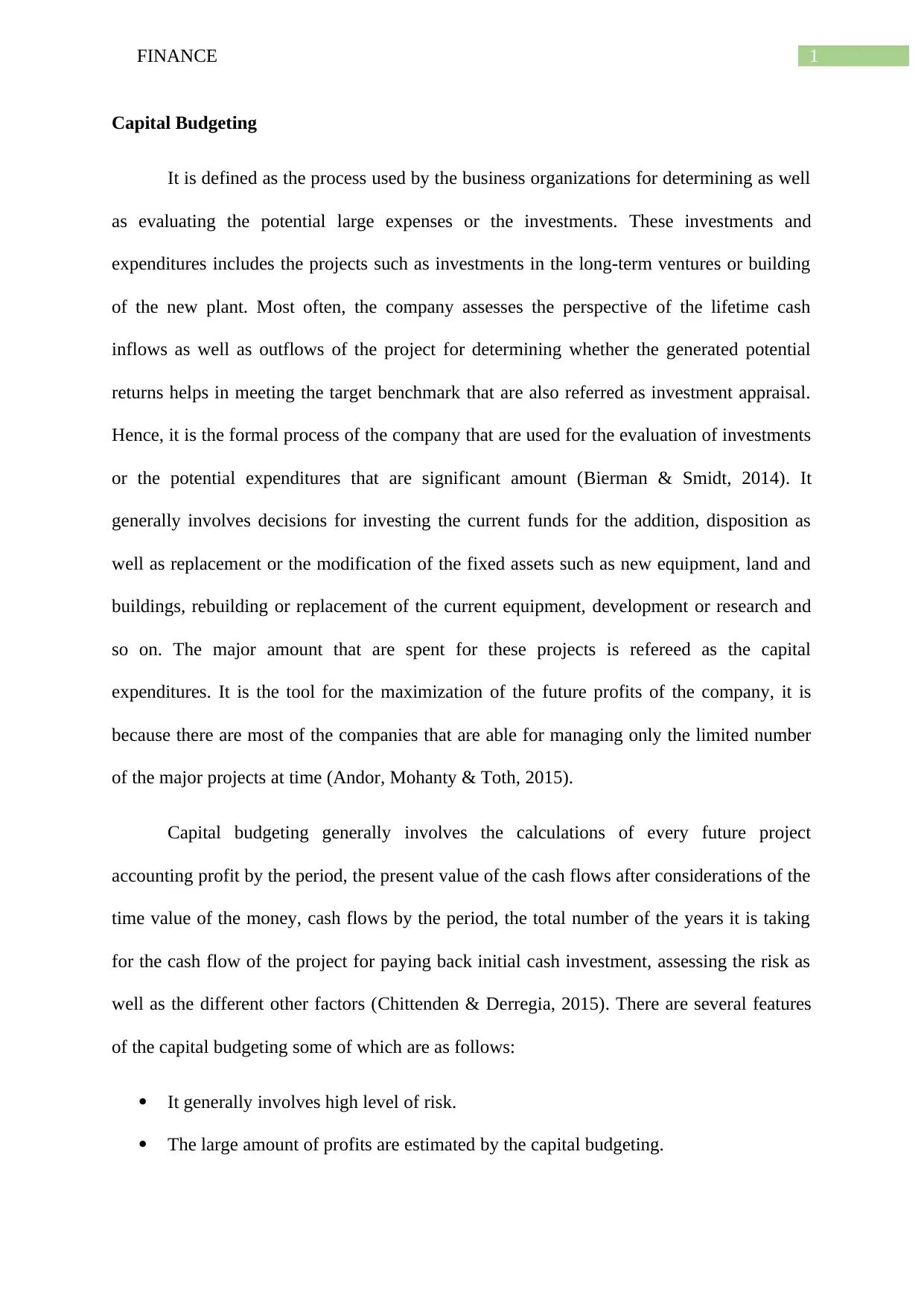
1FINANCE
Capital Budgeting
It is defined as the process used by the business organizations for determining as well
as evaluating the potential large expenses or the investments. These investments and
expenditures includes the projects such as investments in the long-term ventures or building
of the new plant. Most often, the company assesses the perspective of the lifetime cash
inflows as well as outflows of the project for determining whether the generated potential
returns helps in meeting the target benchmark that are also referred as investment appraisal.
Hence, it is the formal process of the company that are used for the evaluation of investments
or the potential expenditures that are significant amount (Bierman & Smidt, 2014). It
generally involves decisions for investing the current funds for the addition, disposition as
well as replacement or the modification of the fixed assets such as new equipment, land and
buildings, rebuilding or replacement of the current equipment, development or research and
so on. The major amount that are spent for these projects is refereed as the capital
expenditures. It is the tool for the maximization of the future profits of the company, it is
because there are most of the companies that are able for managing only the limited number
of the major projects at time (Andor, Mohanty & Toth, 2015).
Capital budgeting generally involves the calculations of every future project
accounting profit by the period, the present value of the cash flows after considerations of the
time value of the money, cash flows by the period, the total number of the years it is taking
for the cash flow of the project for paying back initial cash investment, assessing the risk as
well as the different other factors (Chittenden & Derregia, 2015). There are several features
of the capital budgeting some of which are as follows:
It generally involves high level of risk.
The large amount of profits are estimated by the capital budgeting.
Capital Budgeting
It is defined as the process used by the business organizations for determining as well
as evaluating the potential large expenses or the investments. These investments and
expenditures includes the projects such as investments in the long-term ventures or building
of the new plant. Most often, the company assesses the perspective of the lifetime cash
inflows as well as outflows of the project for determining whether the generated potential
returns helps in meeting the target benchmark that are also referred as investment appraisal.
Hence, it is the formal process of the company that are used for the evaluation of investments
or the potential expenditures that are significant amount (Bierman & Smidt, 2014). It
generally involves decisions for investing the current funds for the addition, disposition as
well as replacement or the modification of the fixed assets such as new equipment, land and
buildings, rebuilding or replacement of the current equipment, development or research and
so on. The major amount that are spent for these projects is refereed as the capital
expenditures. It is the tool for the maximization of the future profits of the company, it is
because there are most of the companies that are able for managing only the limited number
of the major projects at time (Andor, Mohanty & Toth, 2015).
Capital budgeting generally involves the calculations of every future project
accounting profit by the period, the present value of the cash flows after considerations of the
time value of the money, cash flows by the period, the total number of the years it is taking
for the cash flow of the project for paying back initial cash investment, assessing the risk as
well as the different other factors (Chittenden & Derregia, 2015). There are several features
of the capital budgeting some of which are as follows:
It generally involves high level of risk.
The large amount of profits are estimated by the capital budgeting.
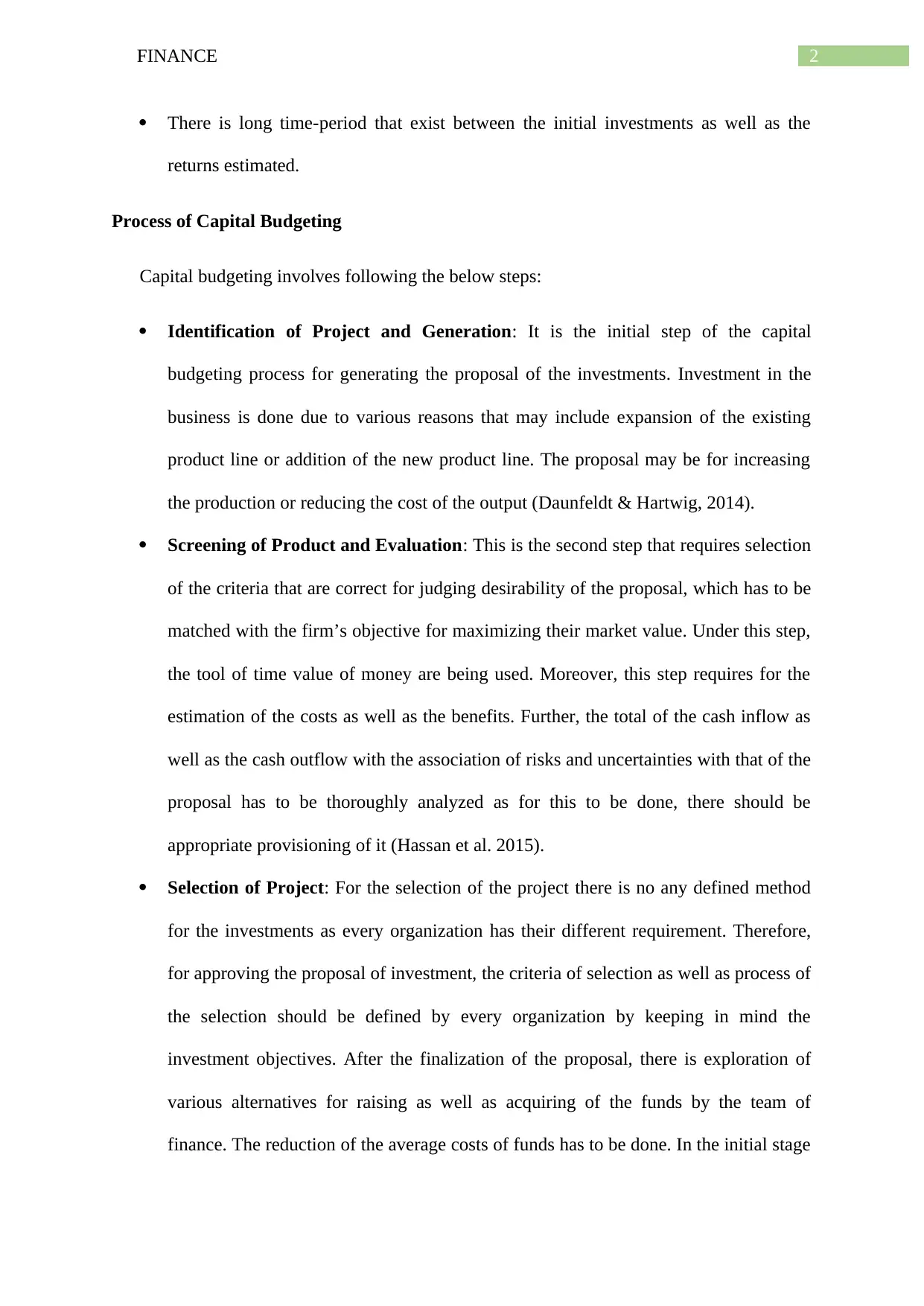
2FINANCE
There is long time-period that exist between the initial investments as well as the
returns estimated.
Process of Capital Budgeting
Capital budgeting involves following the below steps:
Identification of Project and Generation: It is the initial step of the capital
budgeting process for generating the proposal of the investments. Investment in the
business is done due to various reasons that may include expansion of the existing
product line or addition of the new product line. The proposal may be for increasing
the production or reducing the cost of the output (Daunfeldt & Hartwig, 2014).
Screening of Product and Evaluation: This is the second step that requires selection
of the criteria that are correct for judging desirability of the proposal, which has to be
matched with the firm’s objective for maximizing their market value. Under this step,
the tool of time value of money are being used. Moreover, this step requires for the
estimation of the costs as well as the benefits. Further, the total of the cash inflow as
well as the cash outflow with the association of risks and uncertainties with that of the
proposal has to be thoroughly analyzed as for this to be done, there should be
appropriate provisioning of it (Hassan et al. 2015).
Selection of Project: For the selection of the project there is no any defined method
for the investments as every organization has their different requirement. Therefore,
for approving the proposal of investment, the criteria of selection as well as process of
the selection should be defined by every organization by keeping in mind the
investment objectives. After the finalization of the proposal, there is exploration of
various alternatives for raising as well as acquiring of the funds by the team of
finance. The reduction of the average costs of funds has to be done. In the initial stage
There is long time-period that exist between the initial investments as well as the
returns estimated.
Process of Capital Budgeting
Capital budgeting involves following the below steps:
Identification of Project and Generation: It is the initial step of the capital
budgeting process for generating the proposal of the investments. Investment in the
business is done due to various reasons that may include expansion of the existing
product line or addition of the new product line. The proposal may be for increasing
the production or reducing the cost of the output (Daunfeldt & Hartwig, 2014).
Screening of Product and Evaluation: This is the second step that requires selection
of the criteria that are correct for judging desirability of the proposal, which has to be
matched with the firm’s objective for maximizing their market value. Under this step,
the tool of time value of money are being used. Moreover, this step requires for the
estimation of the costs as well as the benefits. Further, the total of the cash inflow as
well as the cash outflow with the association of risks and uncertainties with that of the
proposal has to be thoroughly analyzed as for this to be done, there should be
appropriate provisioning of it (Hassan et al. 2015).
Selection of Project: For the selection of the project there is no any defined method
for the investments as every organization has their different requirement. Therefore,
for approving the proposal of investment, the criteria of selection as well as process of
the selection should be defined by every organization by keeping in mind the
investment objectives. After the finalization of the proposal, there is exploration of
various alternatives for raising as well as acquiring of the funds by the team of
finance. The reduction of the average costs of funds has to be done. In the initial stage
You're viewing a preview
Unlock full access by subscribing today!
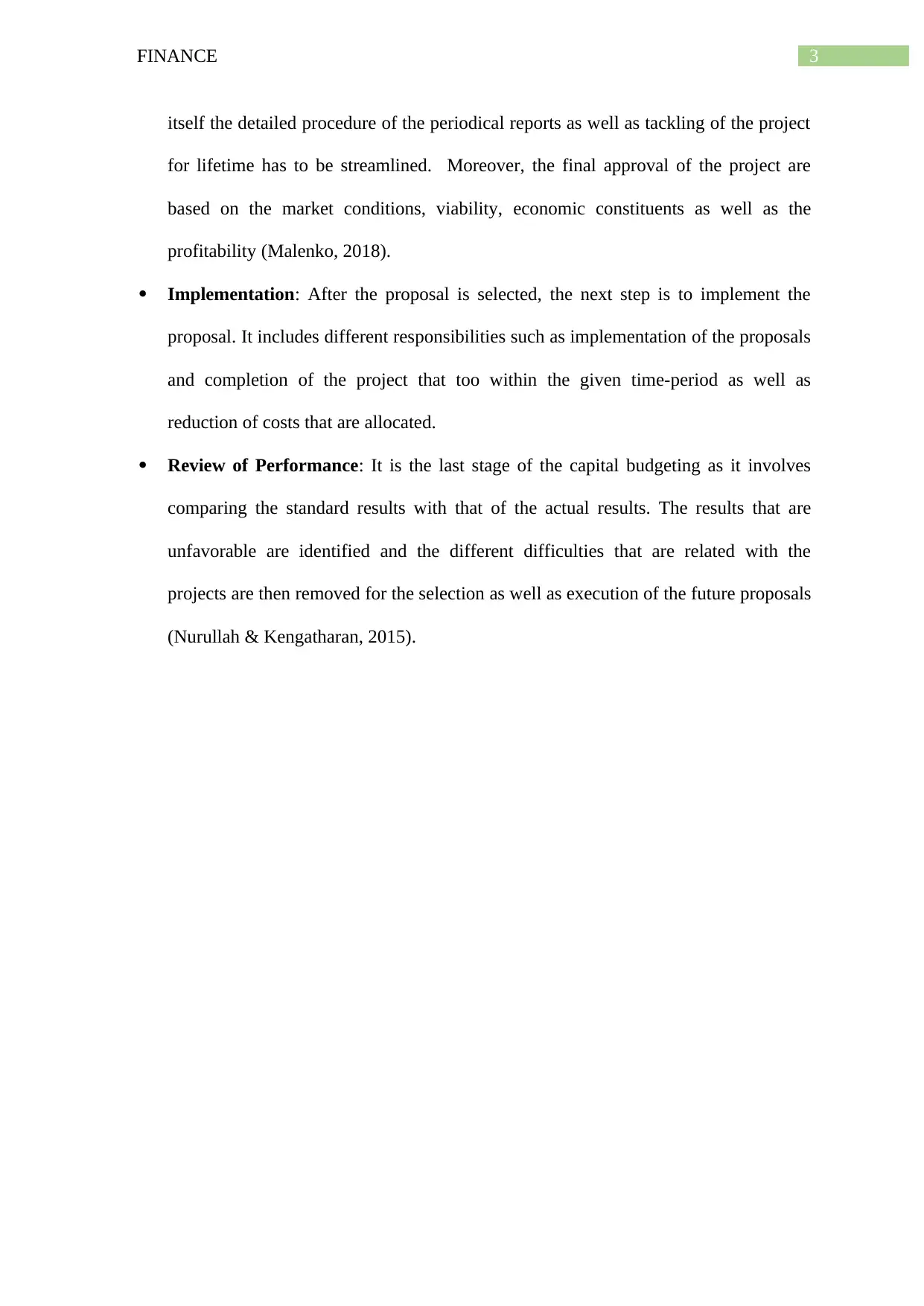
3FINANCE
itself the detailed procedure of the periodical reports as well as tackling of the project
for lifetime has to be streamlined. Moreover, the final approval of the project are
based on the market conditions, viability, economic constituents as well as the
profitability (Malenko, 2018).
Implementation: After the proposal is selected, the next step is to implement the
proposal. It includes different responsibilities such as implementation of the proposals
and completion of the project that too within the given time-period as well as
reduction of costs that are allocated.
Review of Performance: It is the last stage of the capital budgeting as it involves
comparing the standard results with that of the actual results. The results that are
unfavorable are identified and the different difficulties that are related with the
projects are then removed for the selection as well as execution of the future proposals
(Nurullah & Kengatharan, 2015).
itself the detailed procedure of the periodical reports as well as tackling of the project
for lifetime has to be streamlined. Moreover, the final approval of the project are
based on the market conditions, viability, economic constituents as well as the
profitability (Malenko, 2018).
Implementation: After the proposal is selected, the next step is to implement the
proposal. It includes different responsibilities such as implementation of the proposals
and completion of the project that too within the given time-period as well as
reduction of costs that are allocated.
Review of Performance: It is the last stage of the capital budgeting as it involves
comparing the standard results with that of the actual results. The results that are
unfavorable are identified and the different difficulties that are related with the
projects are then removed for the selection as well as execution of the future proposals
(Nurullah & Kengatharan, 2015).
Paraphrase This Document
Need a fresh take? Get an instant paraphrase of this document with our AI Paraphraser

4FINANCE
Decisions of Capital Budgeting
The essence of the capital budgeting is the maximization of the profit. It can be done
in two ways that is either by increasing the revenues or reducing the costs that are associated.
The revenues can be increased by the expanding the operations with the help of adding the
new product line. Reduction of the costs means representations of the obsolete returns on the
assets (Regan et al. 2015). Following are the main decisions of the capital budgeting:
Accept or the Reject Decision- Organization invest in the proposal in case of the
acceptance of the proposal and in case of rejection of the proposal, the organization
does not accepts in the proposal. Generally, the organization accepts those proposal
which yields greater rate of the return as compare to the certain cost of the capital or
required rate of the return. However, all the independent projects are usually accepted.
Independent projects are the projects, which does not compete with the one another in
such way that the acceptance gives the fair possibility for the acceptance of the other.
Mutually Exclusive Decision of Project- The projects of the mutually exclusive
competes with the other projects in the way that accepting the one project will
excludes the rejection of the other projects. Under this, only one project is chosen.
Investment decisions of mutually exclusive gains the key importance, in case under
accept or reject decision the proposals that are more than one are acceptable. It means
that the best alternatives generally rejects the other alternatives (Rossi, 2015).
Capital Rationing Decision- In the situation in which the organization has funds that
are unlimited then the capital budgeting process becomes simple. In that situation, the
investment proposals that are independent and that yields greater return than that of
the predetermined level are accepted. However, in the actual business scenario, there
are different picture. They have the capital budget that is fixed with the so many
proposals of investment that are competing for it. Therefore, capital rationing is
Decisions of Capital Budgeting
The essence of the capital budgeting is the maximization of the profit. It can be done
in two ways that is either by increasing the revenues or reducing the costs that are associated.
The revenues can be increased by the expanding the operations with the help of adding the
new product line. Reduction of the costs means representations of the obsolete returns on the
assets (Regan et al. 2015). Following are the main decisions of the capital budgeting:
Accept or the Reject Decision- Organization invest in the proposal in case of the
acceptance of the proposal and in case of rejection of the proposal, the organization
does not accepts in the proposal. Generally, the organization accepts those proposal
which yields greater rate of the return as compare to the certain cost of the capital or
required rate of the return. However, all the independent projects are usually accepted.
Independent projects are the projects, which does not compete with the one another in
such way that the acceptance gives the fair possibility for the acceptance of the other.
Mutually Exclusive Decision of Project- The projects of the mutually exclusive
competes with the other projects in the way that accepting the one project will
excludes the rejection of the other projects. Under this, only one project is chosen.
Investment decisions of mutually exclusive gains the key importance, in case under
accept or reject decision the proposals that are more than one are acceptable. It means
that the best alternatives generally rejects the other alternatives (Rossi, 2015).
Capital Rationing Decision- In the situation in which the organization has funds that
are unlimited then the capital budgeting process becomes simple. In that situation, the
investment proposals that are independent and that yields greater return than that of
the predetermined level are accepted. However, in the actual business scenario, there
are different picture. They have the capital budget that is fixed with the so many
proposals of investment that are competing for it. Therefore, capital rationing is

5FINANCE
defined as the situation under which the organization has different investments that
are acceptable and that requires large amount of the finance than what is available
with the organization. The projects of investment are ranked based on some of the
predetermined criterion such as rate of return. First rank is given to the project that
have higher return and the projects that are acceptable are ranked thereafter (Sari &
Kahraman, 2015).
defined as the situation under which the organization has different investments that
are acceptable and that requires large amount of the finance than what is available
with the organization. The projects of investment are ranked based on some of the
predetermined criterion such as rate of return. First rank is given to the project that
have higher return and the projects that are acceptable are ranked thereafter (Sari &
Kahraman, 2015).
You're viewing a preview
Unlock full access by subscribing today!
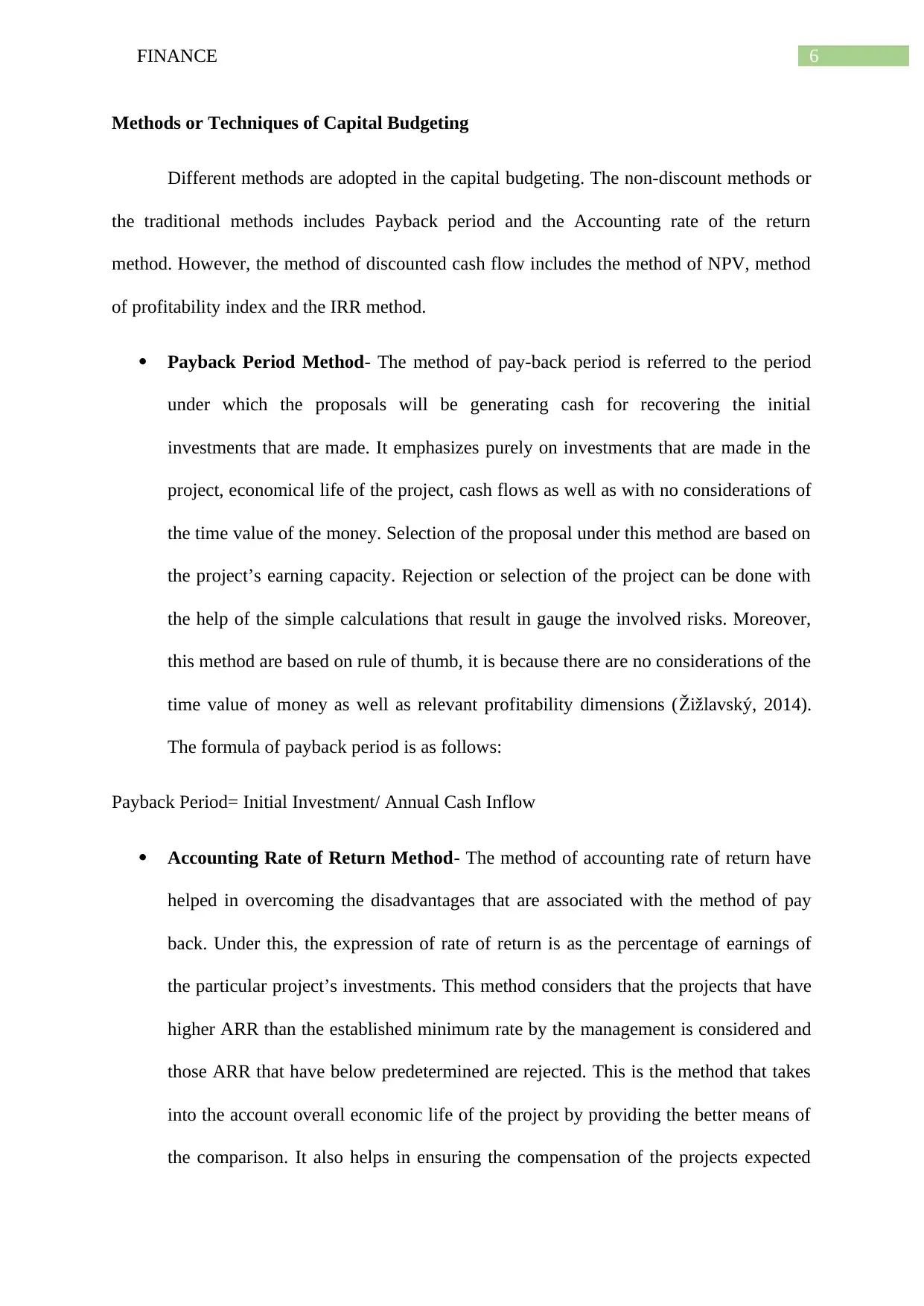
6FINANCE
Methods or Techniques of Capital Budgeting
Different methods are adopted in the capital budgeting. The non-discount methods or
the traditional methods includes Payback period and the Accounting rate of the return
method. However, the method of discounted cash flow includes the method of NPV, method
of profitability index and the IRR method.
Payback Period Method- The method of pay-back period is referred to the period
under which the proposals will be generating cash for recovering the initial
investments that are made. It emphasizes purely on investments that are made in the
project, economical life of the project, cash flows as well as with no considerations of
the time value of the money. Selection of the proposal under this method are based on
the project’s earning capacity. Rejection or selection of the project can be done with
the help of the simple calculations that result in gauge the involved risks. Moreover,
this method are based on rule of thumb, it is because there are no considerations of the
time value of money as well as relevant profitability dimensions (Žižlavský, 2014).
The formula of payback period is as follows:
Payback Period= Initial Investment/ Annual Cash Inflow
Accounting Rate of Return Method- The method of accounting rate of return have
helped in overcoming the disadvantages that are associated with the method of pay
back. Under this, the expression of rate of return is as the percentage of earnings of
the particular project’s investments. This method considers that the projects that have
higher ARR than the established minimum rate by the management is considered and
those ARR that have below predetermined are rejected. This is the method that takes
into the account overall economic life of the project by providing the better means of
the comparison. It also helps in ensuring the compensation of the projects expected
Methods or Techniques of Capital Budgeting
Different methods are adopted in the capital budgeting. The non-discount methods or
the traditional methods includes Payback period and the Accounting rate of the return
method. However, the method of discounted cash flow includes the method of NPV, method
of profitability index and the IRR method.
Payback Period Method- The method of pay-back period is referred to the period
under which the proposals will be generating cash for recovering the initial
investments that are made. It emphasizes purely on investments that are made in the
project, economical life of the project, cash flows as well as with no considerations of
the time value of the money. Selection of the proposal under this method are based on
the project’s earning capacity. Rejection or selection of the project can be done with
the help of the simple calculations that result in gauge the involved risks. Moreover,
this method are based on rule of thumb, it is because there are no considerations of the
time value of money as well as relevant profitability dimensions (Žižlavský, 2014).
The formula of payback period is as follows:
Payback Period= Initial Investment/ Annual Cash Inflow
Accounting Rate of Return Method- The method of accounting rate of return have
helped in overcoming the disadvantages that are associated with the method of pay
back. Under this, the expression of rate of return is as the percentage of earnings of
the particular project’s investments. This method considers that the projects that have
higher ARR than the established minimum rate by the management is considered and
those ARR that have below predetermined are rejected. This is the method that takes
into the account overall economic life of the project by providing the better means of
the comparison. It also helps in ensuring the compensation of the projects expected
Paraphrase This Document
Need a fresh take? Get an instant paraphrase of this document with our AI Paraphraser
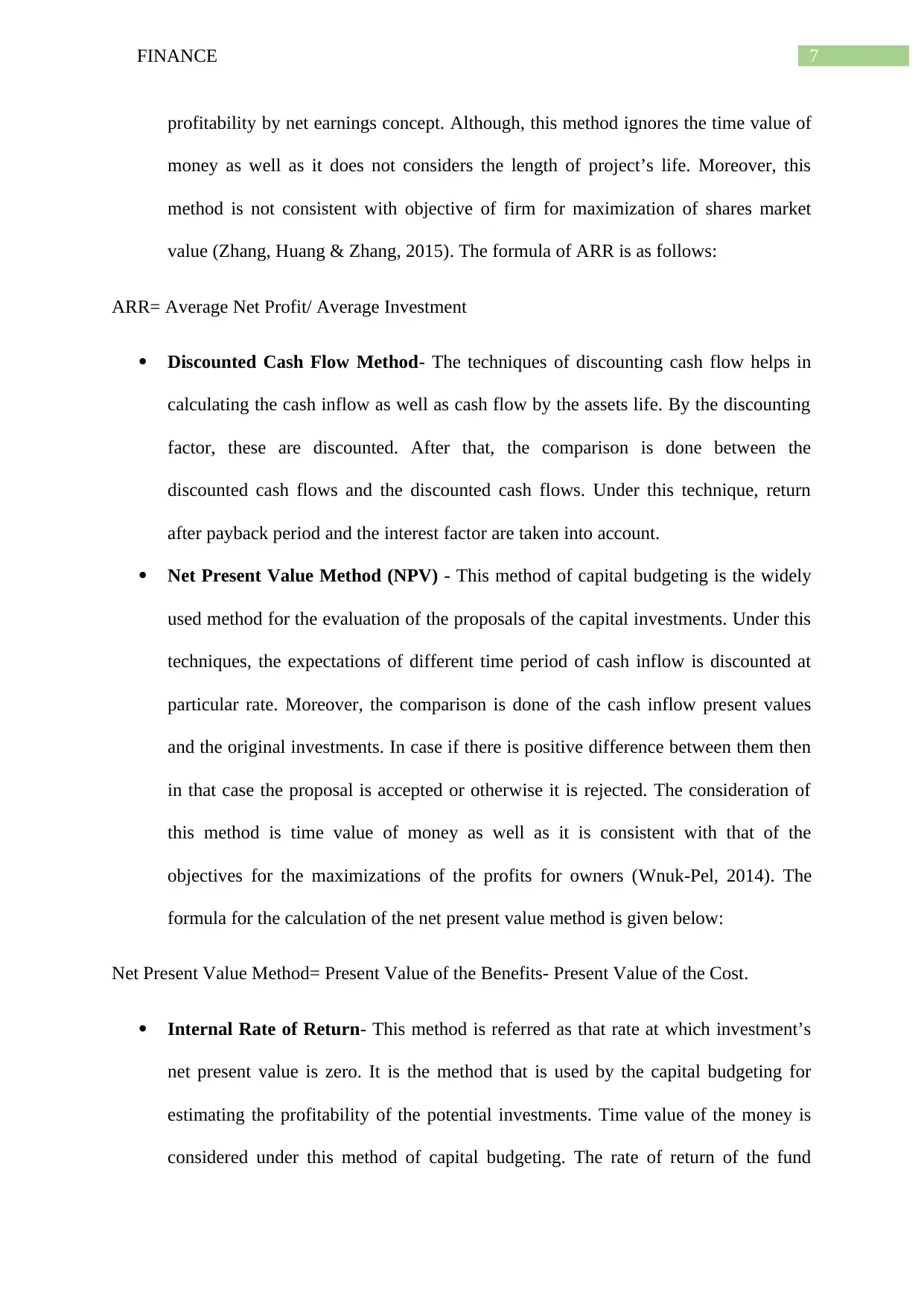
7FINANCE
profitability by net earnings concept. Although, this method ignores the time value of
money as well as it does not considers the length of project’s life. Moreover, this
method is not consistent with objective of firm for maximization of shares market
value (Zhang, Huang & Zhang, 2015). The formula of ARR is as follows:
ARR= Average Net Profit/ Average Investment
Discounted Cash Flow Method- The techniques of discounting cash flow helps in
calculating the cash inflow as well as cash flow by the assets life. By the discounting
factor, these are discounted. After that, the comparison is done between the
discounted cash flows and the discounted cash flows. Under this technique, return
after payback period and the interest factor are taken into account.
Net Present Value Method (NPV) - This method of capital budgeting is the widely
used method for the evaluation of the proposals of the capital investments. Under this
techniques, the expectations of different time period of cash inflow is discounted at
particular rate. Moreover, the comparison is done of the cash inflow present values
and the original investments. In case if there is positive difference between them then
in that case the proposal is accepted or otherwise it is rejected. The consideration of
this method is time value of money as well as it is consistent with that of the
objectives for the maximizations of the profits for owners (Wnuk-Pel, 2014). The
formula for the calculation of the net present value method is given below:
Net Present Value Method= Present Value of the Benefits- Present Value of the Cost.
Internal Rate of Return- This method is referred as that rate at which investment’s
net present value is zero. It is the method that is used by the capital budgeting for
estimating the profitability of the potential investments. Time value of the money is
considered under this method of capital budgeting. The rate of return of the fund
profitability by net earnings concept. Although, this method ignores the time value of
money as well as it does not considers the length of project’s life. Moreover, this
method is not consistent with objective of firm for maximization of shares market
value (Zhang, Huang & Zhang, 2015). The formula of ARR is as follows:
ARR= Average Net Profit/ Average Investment
Discounted Cash Flow Method- The techniques of discounting cash flow helps in
calculating the cash inflow as well as cash flow by the assets life. By the discounting
factor, these are discounted. After that, the comparison is done between the
discounted cash flows and the discounted cash flows. Under this technique, return
after payback period and the interest factor are taken into account.
Net Present Value Method (NPV) - This method of capital budgeting is the widely
used method for the evaluation of the proposals of the capital investments. Under this
techniques, the expectations of different time period of cash inflow is discounted at
particular rate. Moreover, the comparison is done of the cash inflow present values
and the original investments. In case if there is positive difference between them then
in that case the proposal is accepted or otherwise it is rejected. The consideration of
this method is time value of money as well as it is consistent with that of the
objectives for the maximizations of the profits for owners (Wnuk-Pel, 2014). The
formula for the calculation of the net present value method is given below:
Net Present Value Method= Present Value of the Benefits- Present Value of the Cost.
Internal Rate of Return- This method is referred as that rate at which investment’s
net present value is zero. It is the method that is used by the capital budgeting for
estimating the profitability of the potential investments. Time value of the money is
considered under this method of capital budgeting. The rate of return of the fund
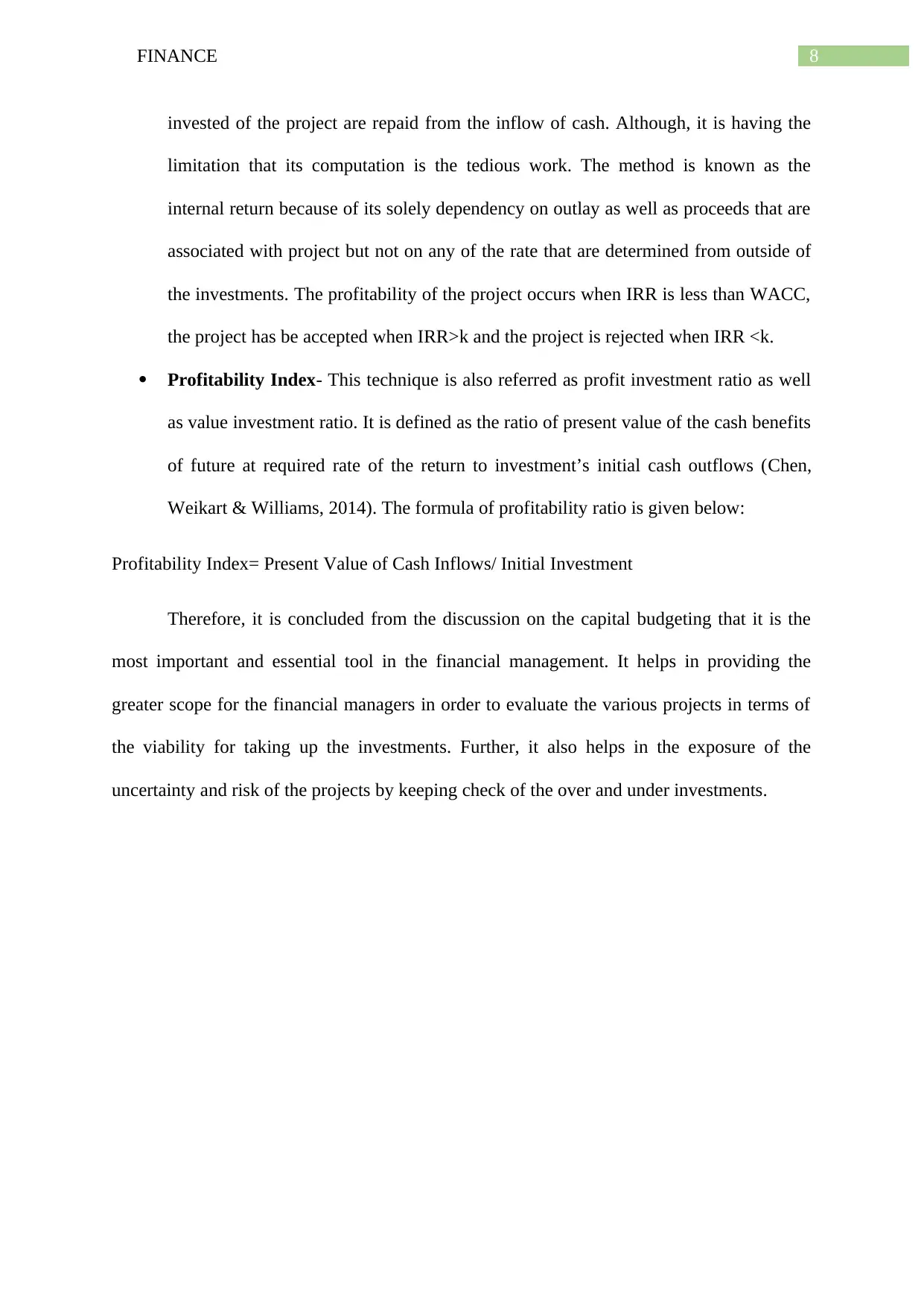
8FINANCE
invested of the project are repaid from the inflow of cash. Although, it is having the
limitation that its computation is the tedious work. The method is known as the
internal return because of its solely dependency on outlay as well as proceeds that are
associated with project but not on any of the rate that are determined from outside of
the investments. The profitability of the project occurs when IRR is less than WACC,
the project has be accepted when IRR>k and the project is rejected when IRR <k.
Profitability Index- This technique is also referred as profit investment ratio as well
as value investment ratio. It is defined as the ratio of present value of the cash benefits
of future at required rate of the return to investment’s initial cash outflows (Chen,
Weikart & Williams, 2014). The formula of profitability ratio is given below:
Profitability Index= Present Value of Cash Inflows/ Initial Investment
Therefore, it is concluded from the discussion on the capital budgeting that it is the
most important and essential tool in the financial management. It helps in providing the
greater scope for the financial managers in order to evaluate the various projects in terms of
the viability for taking up the investments. Further, it also helps in the exposure of the
uncertainty and risk of the projects by keeping check of the over and under investments.
invested of the project are repaid from the inflow of cash. Although, it is having the
limitation that its computation is the tedious work. The method is known as the
internal return because of its solely dependency on outlay as well as proceeds that are
associated with project but not on any of the rate that are determined from outside of
the investments. The profitability of the project occurs when IRR is less than WACC,
the project has be accepted when IRR>k and the project is rejected when IRR <k.
Profitability Index- This technique is also referred as profit investment ratio as well
as value investment ratio. It is defined as the ratio of present value of the cash benefits
of future at required rate of the return to investment’s initial cash outflows (Chen,
Weikart & Williams, 2014). The formula of profitability ratio is given below:
Profitability Index= Present Value of Cash Inflows/ Initial Investment
Therefore, it is concluded from the discussion on the capital budgeting that it is the
most important and essential tool in the financial management. It helps in providing the
greater scope for the financial managers in order to evaluate the various projects in terms of
the viability for taking up the investments. Further, it also helps in the exposure of the
uncertainty and risk of the projects by keeping check of the over and under investments.
You're viewing a preview
Unlock full access by subscribing today!

9FINANCE
Reference
Andor, G., Mohanty, S. K., & Toth, T. (2015). Capital budgeting practices: A survey of
Central and Eastern European firms. Emerging Markets Review, 23, 148-172.
Bierman Jr, H., & Smidt, S. (2014). Advanced capital budgeting: Refinements in the
economic analysis of investment projects. Routledge.
Chen, G. G., Weikart, L. A., & Williams, D. W. (2014). Budget tools: Financial methods in
the public sector. CQ Press.
Chittenden, F., & Derregia, M. (2015). Uncertainty, irreversibility and the use of ‘rules of
thumb’in capital budgeting. The British Accounting Review, 47(3), 225-236.
Daunfeldt, S. O., & Hartwig, F. (2014). What determines the use of capital budgeting
methods?: Evidence from Swedish listed companies. Journal of Finance and
Economics, 2(4), 101-112.
Hassan, A., Saadawi, M., Kandil, M., & Saeed, M. (2015). Modified particle swarm
optimisation technique for optimal design of small renewable energy system
supplying a specific load at Mansoura University. IET Renewable Power
Generation, 9(5), 474-483.
Malenko, A. (2018). Optimal dynamic capital budgeting. Available at SSRN 1710884.
Nurullah, M., & Kengatharan, L. (2015). Capital budgeting practices: evidence from Sri
Lanka. Journal of Advances in Management Research, 12(1), 55-82.
Regan, C. M., Bryan, B. A., Connor, J. D., Meyer, W. S., Ostendorf, B., Zhu, Z., & Bao, C.
(2015). Real options analysis for land use management: Methods, application, and
implications for policy. Journal of environmental management, 161, 144-152.
Reference
Andor, G., Mohanty, S. K., & Toth, T. (2015). Capital budgeting practices: A survey of
Central and Eastern European firms. Emerging Markets Review, 23, 148-172.
Bierman Jr, H., & Smidt, S. (2014). Advanced capital budgeting: Refinements in the
economic analysis of investment projects. Routledge.
Chen, G. G., Weikart, L. A., & Williams, D. W. (2014). Budget tools: Financial methods in
the public sector. CQ Press.
Chittenden, F., & Derregia, M. (2015). Uncertainty, irreversibility and the use of ‘rules of
thumb’in capital budgeting. The British Accounting Review, 47(3), 225-236.
Daunfeldt, S. O., & Hartwig, F. (2014). What determines the use of capital budgeting
methods?: Evidence from Swedish listed companies. Journal of Finance and
Economics, 2(4), 101-112.
Hassan, A., Saadawi, M., Kandil, M., & Saeed, M. (2015). Modified particle swarm
optimisation technique for optimal design of small renewable energy system
supplying a specific load at Mansoura University. IET Renewable Power
Generation, 9(5), 474-483.
Malenko, A. (2018). Optimal dynamic capital budgeting. Available at SSRN 1710884.
Nurullah, M., & Kengatharan, L. (2015). Capital budgeting practices: evidence from Sri
Lanka. Journal of Advances in Management Research, 12(1), 55-82.
Regan, C. M., Bryan, B. A., Connor, J. D., Meyer, W. S., Ostendorf, B., Zhu, Z., & Bao, C.
(2015). Real options analysis for land use management: Methods, application, and
implications for policy. Journal of environmental management, 161, 144-152.
Paraphrase This Document
Need a fresh take? Get an instant paraphrase of this document with our AI Paraphraser

10FINANCE
Rossi, M. (2015). The use of capital budgeting techniques: an outlook from
Italy. International Journal of Management Practice, 8(1), 43-56.
Salehi, K. (2015). A hybrid fuzzy MCDM approach for project selection problem. Decision
Science Letters, 4(1), 109-116.
Sari, I. U., & Kahraman, C. (2015). Interval type-2 fuzzy capital budgeting. International
Journal of Fuzzy Systems, 17(4), 635-646.
Wnuk-Pel, T. (2014). The practice and factors determining the selection of capital budgeting
methods–evidence from the field. Procedia-Social and Behavioral Sciences, 156,
612-616.
Zhang, Q., Huang, X., & Zhang, C. (2015). A mean-risk index model for uncertain capital
budgeting. Journal of the Operational Research Society, 66(5), 761-770.
Žižlavský, O. (2014). Net present value approach: method for economic assessment of
innovation projects. Procedia-Social and Behavioral Sciences, 156, 506-512.
Rossi, M. (2015). The use of capital budgeting techniques: an outlook from
Italy. International Journal of Management Practice, 8(1), 43-56.
Salehi, K. (2015). A hybrid fuzzy MCDM approach for project selection problem. Decision
Science Letters, 4(1), 109-116.
Sari, I. U., & Kahraman, C. (2015). Interval type-2 fuzzy capital budgeting. International
Journal of Fuzzy Systems, 17(4), 635-646.
Wnuk-Pel, T. (2014). The practice and factors determining the selection of capital budgeting
methods–evidence from the field. Procedia-Social and Behavioral Sciences, 156,
612-616.
Zhang, Q., Huang, X., & Zhang, C. (2015). A mean-risk index model for uncertain capital
budgeting. Journal of the Operational Research Society, 66(5), 761-770.
Žižlavský, O. (2014). Net present value approach: method for economic assessment of
innovation projects. Procedia-Social and Behavioral Sciences, 156, 506-512.
1 out of 11
Related Documents
Your All-in-One AI-Powered Toolkit for Academic Success.
+13062052269
info@desklib.com
Available 24*7 on WhatsApp / Email
![[object Object]](/_next/static/media/star-bottom.7253800d.svg)
Unlock your academic potential
© 2024 | Zucol Services PVT LTD | All rights reserved.




